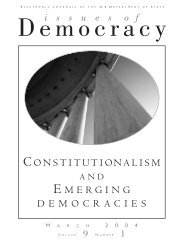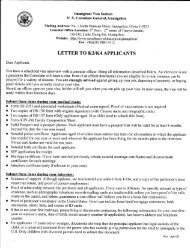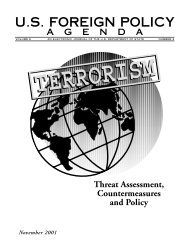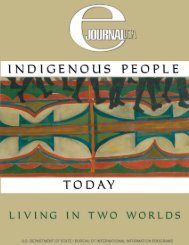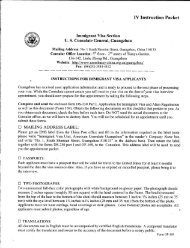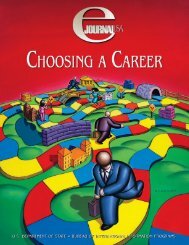s. history us history us history - Embassy of the United States
s. history us history us history - Embassy of the United States
s. history us history us history - Embassy of the United States
- No tags were found...
You also want an ePaper? Increase the reach of your titles
YUMPU automatically turns print PDFs into web optimized ePapers that Google loves.
CHAPTER 9: DISCONTENT AND REFORMOUTLINE OF U.S. HISTORYagainst <strong>the</strong> great railroad baron, JayGould, in 1885. Within a year <strong>the</strong>yadded 500,000 workers to <strong>the</strong>ir rolls,but, not attuned to pragmatic tradeunionism and unable to repeat thissuccess, <strong>the</strong> Knights soon fell intoa decline.Their place in <strong>the</strong> labor movementwas gradually taken by <strong>the</strong>American Federation <strong>of</strong> Labor(AFL). Ra<strong>the</strong>r than open membershipto all, <strong>the</strong> AFL, under former cigarunion <strong>of</strong>ficial Samuel Gompers,was a group <strong>of</strong> unions foc<strong>us</strong>ed onskilled workers. Its objectives were“pure and simple” and apolitical:increasing wages, reducing hours,and improving working conditions.It did much to turn <strong>the</strong> labor movementaway from <strong>the</strong> socialist views<strong>of</strong> most European labor movements.None<strong>the</strong>less, both before <strong>the</strong>founding <strong>of</strong> <strong>the</strong> AFL and after,American labor <strong>history</strong> was violent.In <strong>the</strong> Great Rail Strike <strong>of</strong> 1877, railworkers across <strong>the</strong> nation went outin response to a 10-percent pay cut.Attempts to break <strong>the</strong> strike led to riotingand wide-scale destruction inseveral cities: Baltimore, Maryland;Chicago, Illinois; Pittsburgh, Pennsylvania;Buffalo, New York; andSan Francisco, California. Federaltroops had to be sent to several locationsbefore <strong>the</strong> strike was ended.Nine years later, in Chicago’sHaymarket Square incident, someonethrew a bomb at police aboutto break up an anarchist rally insupport <strong>of</strong> an ongoing strike at <strong>the</strong>McCormick Harvester Company inChicago. In <strong>the</strong> ensuing melee, sevenpolicemen and at least four workerswere reported killed. Some 60 police<strong>of</strong>ficers were injured.In 1892, at Carnegie’s steel worksin Homestead, Pennsylvania, agroup <strong>of</strong> 300 Pinkerton detectives<strong>the</strong> company had hired to break abitter strike by <strong>the</strong> AmalgamatedAssociation <strong>of</strong> Iron, Steel, and TinWorkers fought a fierce and losinggun battle with strikers. The NationalGuard was called in to protectnon-union workers and <strong>the</strong> strikewas broken. Unions were not letback into <strong>the</strong> plant until 1937.In 1894, wage cuts at <strong>the</strong> PullmanCompany j<strong>us</strong>t outside Chicago led toa strike, which, with <strong>the</strong> support <strong>of</strong><strong>the</strong> American Railway Union, soontied up much <strong>of</strong> <strong>the</strong> country’s railsystem. As <strong>the</strong> situation deteriorated,U.S. Attorney General RichardOlney, himself a former railroadlawyer, deputized over 3,000 menin an attempt to keep <strong>the</strong> rails open.This was followed by a federal courtinjunction against union interferencewith <strong>the</strong> trains. When riotingensued, President Cleveland sent infederal troops, and <strong>the</strong> strike waseventually broken.The most militant <strong>of</strong> <strong>the</strong> strikefavoringunions was <strong>the</strong> Ind<strong>us</strong>trialWorkers <strong>of</strong> <strong>the</strong> World (IWW).Formed from an amalgam <strong>of</strong> unionsfighting for better conditions in <strong>the</strong>West’s mining ind<strong>us</strong>try, <strong>the</strong> IWW, or“Wobblies” as <strong>the</strong>y were commonlyknown, gained particular prominencefrom <strong>the</strong> Colorado mineclashes <strong>of</strong> 1903 and <strong>the</strong> singularlybrutal fashion in which <strong>the</strong>y wereput down. Influenced by militantanarchism and openly calling forclass warfare, <strong>the</strong> Wobblies gainedmany adherents after <strong>the</strong>y won a difficultstrike battle in <strong>the</strong> textile mills<strong>of</strong> Lawrence, Massach<strong>us</strong>etts, in 1912.Their call for work stoppages in <strong>the</strong>midst <strong>of</strong> World War I, however, ledto a government crackdown in 1917that virtually destroyed <strong>the</strong>m.THE REFORM IMPULSEThe presidential election <strong>of</strong> 1900gave <strong>the</strong> American people a chanceto pass judgment on <strong>the</strong> Republicanadministration <strong>of</strong> President McKinley,especially its foreign policy.Meeting at Philadelphia, <strong>the</strong> Republicansexpressed jubilation over <strong>the</strong>successful outcome <strong>of</strong> <strong>the</strong> war withSpain, <strong>the</strong> restoration <strong>of</strong> prosperity,and <strong>the</strong> effort to obtain new marketsthrough <strong>the</strong> Open Door policy.McKinley easily defeated his opponent,once again William JenningsBryan. But <strong>the</strong> president did not liveto enjoy his victory. In September1901, while attending an expositionin Buffalo, New York, he wasshot down by an assassin, <strong>the</strong> thirdpresident to be assassinated since <strong>the</strong>Civil War.Theodore Roosevelt, McKinley’svice president, assumed <strong>the</strong> presidency.Roosevelt’s accession coincidedwith a new epoch in Americanpolitical life and international relations.The continent was peopled;<strong>the</strong> frontier was disappearing. Asmall, formerly struggling republichad become a world power. Thecountry’s political foundations hadendured <strong>the</strong> vicissitudes <strong>of</strong> foreignand civil war, <strong>the</strong> tides <strong>of</strong> prosperityand depression. Immense strideshad been made in agriculture andind<strong>us</strong>try. Free public education hadbeen largely realized and a free pressmaintained. The ideal <strong>of</strong> religio<strong>us</strong>freedom had been s<strong>us</strong>tained. Theinfluence <strong>of</strong> big b<strong>us</strong>iness was nowmore firmly entrenched than ever,however, and local and municipalgovernment <strong>of</strong>ten was in <strong>the</strong> hands<strong>of</strong> corrupt politicians.In response to <strong>the</strong> excesses <strong>of</strong>19th-century capitalism and politicalcorruption, a reform movementarose called “progressivism,” whichgave American politics and thoughtits special character from approximately1890 until <strong>the</strong> Americanentry into World War I in 1917. TheProgressives had diverse objectives.In general, however, <strong>the</strong>y saw <strong>the</strong>mselvesas engaged in a democraticcr<strong>us</strong>ade against <strong>the</strong> ab<strong>us</strong>es <strong>of</strong> urbanpolitical bosses and <strong>the</strong> corrupt“robber barons” <strong>of</strong> big b<strong>us</strong>iness.Their goals were greater democracyand social j<strong>us</strong>tice, honest government,more effective regulation <strong>of</strong>b<strong>us</strong>iness, and a revived commitmentto public service. They believed thatexpanding <strong>the</strong> scope <strong>of</strong> governmentwould ensure <strong>the</strong> progress <strong>of</strong> U.S. societyand <strong>the</strong> welfare <strong>of</strong> its citizens.The years 1902 to 1908 marked<strong>the</strong> era <strong>of</strong> greatest reform activity,as writers and journalists stronglyprotested practices and principlesinherited from <strong>the</strong> 18th-centuryrural republic that were proving194195



